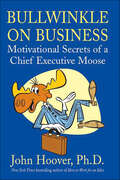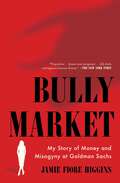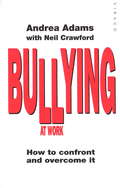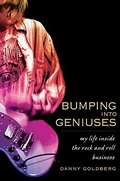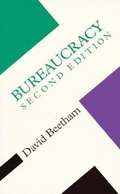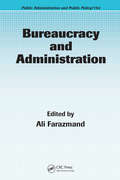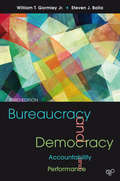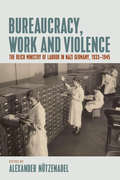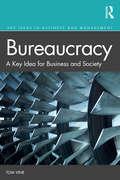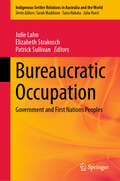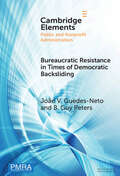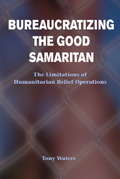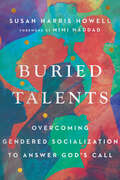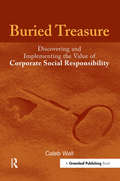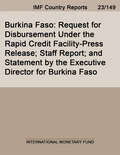- Table View
- List View
Bullwinkle on Business: Motivational Secrets of a Chief Executive Moose
by John HooverBullwinkle on Business is a delightful 10-lesson business course disguised as a humorous tale featuring the beloved TV characters Bullwinkle J. Moose, Rocky the Flying Squirrel, Boris Badenov and Natasha, and Peabody the dog and his boy Sherman.Sooner or later it was bound to happen. The world of business has now grown hungry for a fresh, new voice to speak out for organizational excellence in the free enterprise system.But where is a great leader who possesses the stature, the stamina, and the swagger to be called the consummate CEO? Who can grasp the helm of business in a shifting global economy and steady the ship? Who can capture the confidence of consumers and anxious business professionals on every continent and calm their anxiety with nerves of steel?Look no further than Frostbite Falls, Minnesota. Cast your eyes toward that imposing figure with antlers spread wide and a profile that protrudes into next week. Step aside Warren Bennis, Ken Blanchard, Jim Collins, Steven Covey, Spencer Johnson, Donald Trump, and even Jack Welch. Make way for that superb snout that belongs to none other than the magnificent moose himself, Bullwinkle.But how can a solitary moose, revered by millions, maintain his competitive edge amidst so much acclaim? How can he focus in the blinding spotlight of fame and fortune? How can he sustain a significant value proposition when he can't even spell the term? By teaming up with someone more talented, intelligent, and resourceful, of course. And so the saga of Bullwinkle J. Moose and his better angel, Rocket J. "Rocky" Squirrel begins. Bullwinkle and his better angel, Rocky, become the Chief Executive and Chief People Officers, respectively, of the Frostbite Falls Mitten Company. But Bullwinkle is soon seduced by the trappings of power and prestige. He begins to believe his own press clippings and forgets who makes the business run and who the business exists to serve.The antics of Bullwinkle's bungling and misguided management consultants, Boris and Natasha, only serve to auger the maladroit moose deeper into his own entropy. Former communist comrades—now turned capitalist colleagues—Fearless Leader (now Chief Evil Officer) sends his most notorious spies to steal Western business secrets.Mr. Peabody and his adroit pupil, Sherman, use the WayBac Machine to monitor lessons learned from leaders throughout history. The Beagle and his adopted boy draw concise correlations to how Rocky helps his much-headed friend learn that only enthusiastic people can energize an enterprise. By teaching Bullwinkle to unleash the collective wisdom, experience, and talent of his team members, Rocky transforms a moose with marginal managerial potential into a magnificent motivator.You won't want to miss a single episode of John Hoover's BULLWINKLE ON BUSINESS.
Bully Market: My Story of Money and Misogyny at Goldman Sachs
by Jamie Fiore HigginsA rare, riveting insider&’s account on Wall Street—an updated Liar&’s Poker—where greed coupled with misogyny and discrimination enforces a culture of exclusion in the upper echelons of Goldman SachsJamie Fiore Higgins became one of the few women at the highest ranks of Goldman Sachs. Spurred on by the obligation she felt to her working-class immigrant family, she rose through the ranks and saw it all: out-of-control, lavish parties flowing with never-ending drinks; affairs flouted in the office; rampant drug use; and most pervasively, a discriminatory culture that seemed designed to hold back the few women and people of color employed at the company. Despite Goldman Sachs having the right talking points and statistics, Fiore Higgins soon realized that these provided a veneer to cover up what she found to be an abusive culture. Her account is one filled with shocking stories of harassment and jaw-dropping tales of exclusionary behavior: when she was told she only got promoted because she is a woman; when her coworkers mooed at her after she pumped for her fourth child, defying the superior who had advised her not to breastfeed; or when a male boss used a racial epithet in front of her, other colleagues, and clients without any repercussions. Bully Market sounds the alarm on the culture of finance and corporate America, while offering clear, actionable ideas for creating a fairer workplace. Both a revealing, extraordinary look at the industry and a top Wall Streeter&’s explosive personal story, Bully Market is an essential account of one woman&’s experience in a flawed system that speaks to the challenge and urgency for change.
Bullying At Work: How to Confront and Overcome It
by Andrea AdamsThrough personal accounts and revelations, this book explores bullying at work and offers solutions to help overcome this stressful, often isolating experience facing many women and men. Based on three years of research, Andrea Adams plots the destructive forces currently eroding the professional lives of many people. By tracing the psychological origins of bullying at work this book investigates the effect of past relationships on the present, providing both individuals and organizations with a deeper understanding of why things can go so badly wrong. Through advice and guidance, it offers a way forward for all those who value the need for psychological well-being at the workplace.
Bullying At Work: How to Confront and Overcome It
by Andrea AdamsThrough personal accounts and revelations, this book explores bullying at work and offers solutions to help overcome this stressful, often isolating experience facing many women and men. Based on three years of research, Andrea Adams plots the destructive forces currently eroding the professional lives of many people. By tracing the psychological origins of bullying at work this book investigates the effect of past relationships on the present, providing both individuals and organizations with a deeper understanding of why things can go so badly wrong. Through advice and guidance, it offers a way forward for all those who value the need for psychological well-being at the workplace.
Bumping Into Geniuses
by Danny GoldbergA giant of the music industry grants an all-access pass to the world of rock and roll, with mesmerizing stories of thirty0five years spent working with legends Danny Goldberg has been a hugely influential figure in the world of rock and roll. He did PR for Led Zeppelin; he managed the career of Nirvana; he ran Atlantic, Mercury, and Warner Brothers; he launched Stevie Nick?s solo career. In Bumping into Geniuses, Goldberg grants an all-access pass to the world of rock and roll, with mesmerizing stories of forty years spent working with legends, including Patti Smith, Warren Zevon, Bruce Springsteen, Kiss, Kurt Cobain and Nirvana, Hole, Stevie Nicks, Bonnie Raitt, the Eagles, Susan Blond, Michael Des Barres, Steve Earle, Led Zeppelin, and more. But there?s more to this story than just Goldberg?s varied career. It?s also a look at the industry itself: a business that was complex and chaotic ? a mixture of art and commerce, idealism and selfishness ? and sometimes, rock?s most gifted and influential musicians were able to transcend it all. .
Bundling
by Adam Brandenburger Vijay KrishnaRecent developments in the software business point to some of the reasons why companies offer their products or services in bundles. One is the opportunity to leverage market power, as Microsoft arguably has done by bundling applications software with its operating systems. Another reason for bundling is the economics of scope, as indicated by the emergence of software suites and the shift toward broad-line players (Microsoft, Lotus, and Borland-WordPerfect). But there appears to be still more to bundling: individual software programs continue to be offered in addition to suites, and suites are priced at a steep discount to the total price for the separate programs.
Bunge: Building a Sustainable Future?
by David E. Bell Forest L. Reinhardt Ruth Costas Pedro LevindoBunge, one of the world's leading agribusiness traders and processors, strives to comply with its commitment to having a deforestation-free value chain by 2025 while it considers potential new business growth areas. After a complex turnaround, which involved one of the biggest corporate reorganizations in Bunge's 203-year history, the company finally has surplus cash to invest. CEO Greg Heckman and Chief Sustainability Officer Robert Coviello must figure out if they can turn sustainability into a profit maker for the company or if it will remain as another cost of doing business.
Bunge: Food, Fuel, and World Markets
by Tarun Khanna Jonathan West Santiago MingoIn 2007, Bunge, an agribusiness company, had over $26 billion in worldwide sales and was considered, along with Cargill and Archer Daniels Midland (ADM), one of three very integrated worldwide agribusiness companies. Headquartered in White Plains, NY, the company has traditionally possessed a strong presence in Brazil. Describes Bunge's tradeoff between efficiency of global operations and local responsiveness in an uncertain business environment. New world developments were effecting Bunge directly: high oil prices, a growing demand in emerging economies like China and India, and the possibility of agribusiness companies competing successfully in the production of biofuels. Bunge had traditionally followed an organizational model that was integrated but decentralized, trying to strike a balance between the efficiency of a global entity and the speed of local businesses. What would be the best strategy for Bunge to respond to the external changes imposed by high energy prices and increasing demand from emerging economies? How aggressively should Bunge invest in the rising biofuels markets?
Burberry
by Youngme MoonIn 2003, Rose Marie Bravo, Burberry's CEO, is debating how to maintain the currency and cachet of the brand across its broad customer base, while entering new product categories and expanding distribution. In the past five years, the brand has become one of the hottest luxury brands in the world. But Bravo now faces a number of key decisions, including (1) which new product categories to enter, (2) how to deal with the appropriation of the brand by nontarget customers, and (3) how prominent the company's famed "check" pattern should be in its advertising and clothing. Includes color exhibits.
Burberry in 2014
by Anita ElberseIn February 2014, Burberry's chief executive officer Angela Ahrendts is preparing to hand the reins of the English luxury fashion company to chief creative officer Christopher Bailey. Under Ahrendts and Bailey's partnership, in place since 2006, Burberry's revenues have tripled to more than two billion English pounds, and operating profits have more than doubled. Ahrendts has led Burberry to become a brand that once again stands for luxury and that has a strong global and digital footprint. Yet the leadership change is met with skepticism. Is Burberry's current strategy also the right one for the future, and can Bailey continue Burberry's transformation?
Bureaucracy
by David Beetham Frank ParkinThis revised edition is a useful introduction that provides a compelling analysis of bureaucracy, one of the most pervasive, and yet poorly understood, features of contemporary society. David Beetham addresses the following questions: What is bureaucracy? Are people right to see it as synonymous with red tape and inefficiency? Can it be controlled by politicians. or can it be made more responsive to citizens? Is it confined to the public sector, or is it common to all modern organizations? The second edition has been updated in light of recent academic and political developments, providing a clear guide through the disciplines of sociology, political science, and economics. Beetham also explores competing social theories, including structural, cultural, and rational approaches, and offers a new synthesis that goes beyond them. This clearly written and lucid introduction is essential reading for anyone who seeks to understand the meaning and significance of bureaucracy and its relation to democracy. David Beetham is professor of politics at the University of Leeds. University of Minnesota Press Printed in Great Britain
Bureaucracy and Administration (Public Administration and Public Policy)
by Ali FarazmandBureaucracy is an age-old form of government that has survived since ancient times; it has provided order and persisted with durability, dependability, and stability. The popularity of the first edition of this book, entitled Handbook of Bureaucracy, is testimony to the endurance of bureaucratic institutions. Reflecting the accelerated globalizatio
Bureaucracy and Democracy: Accountability and Performance
by William T. Gormley Steven J. BallaGiven the influence of public bureaucracies in policy implementation, Gormley and Balla assess their performance using four key perspectives—bounded rationality, principal-agent theory, interest group mobilization, and network theory—to help students develop an analytic framework for evaluating bureaucratic accountability.
Bureaucracy, Work and Violence: The Reich Ministry of Labour in Nazi Germany, 1933–1945
by Alexander NützenadelWork played a central role in Nazi ideology and propaganda, and even today there remain some who still emphasize the supposedly positive aspects of the regime’s labor policies, ignoring the horrific and inhumane conditions they produced. This definitive volume provides, for the first time, a systematic study of the Reich Ministry of Labor and its implementation of National Socialist work doctrine. In detailed and illuminating chapters, contributors scrutinize political maneuvering, ministerial operations, relations between party and administration, and individual officials’ actions to reveal the surprising extent to which administrative apparatuses were involved in the Nazi regime and its crimes.
Bureaucracy, Work and Violence: The Reich Ministry of Labour in Nazi Germany, 1933–1945
by Alexander NützenadelWork played a central role in Nazi ideology and propaganda, and even today there remain some who still emphasize the supposedly positive aspects of the regime’s labor policies, ignoring the horrific and inhumane conditions they produced. This definitive volume provides, for the first time, a systematic study of the Reich Ministry of Labor and its implementation of National Socialist work doctrine. In detailed and illuminating chapters, contributors scrutinize political maneuvering, ministerial operations, relations between party and administration, and individual officials’ actions to reveal the surprising extent to which administrative apparatuses were involved in the Nazi regime and its crimes.
Bureaucracy: A Key Idea for Business and Society (Key Ideas in Business and Management)
by Tom VineBureaucracy is a curse – it seems we can’t live with it, we can’t live without it. It is without doubt one of the fundamental ideas which underpin the business world and society at large. In this book, Tom Vine observes, analyses and critiques the concept, placing it at the heart of our understanding of organisation. The author unveils bureaucracy as an endlessly emergent phenomenon which defies binary debate – in analysing organisation, we are all bureaucrats. In building an experiential perspective, the book develops more effective ways to interact with bureaucracy in theory and practice. Empirical material take centre stage, whilst the book employs ethnographic and auto-ethnographic methods to illuminate the existential function of bureaucracy. Taking examples from art, history and culture, this book provides an entertaining alternative academic analysis of bureaucracy as a key idea in business and society which will be essential reading for students and scholars of work and organisation
Bureaucratic Occupation: Government and First Nations Peoples (Indigenous-Settler Relations in Australia and the World #5)
by Patrick Sullivan Elizabeth Strakosch Julie LahnThis volume explores Aboriginal and Torres Strait Islander peoples’ interactions with public sector bureaucracies. The authors featured here consider how bureaucracy relates to colonialism, race, and sovereignty in a post-neoliberal world. They also consider the diverse ways in which Aboriginal and Torres Strait Islander people working within and across these sectors negotiate and engage with bureaucratic structures. Some contributors offer critiques of bureaucratic hierarchies, and others provide insights into the complexity of bureaucratic culture, drawing attention to the complex strategies of Indigenous people who aim to make bureaucracy ‘work’ for themselves and their communities. The volume overall provides a nuanced and substantive analysis of the relation of Aboriginal and Torres Strait Islander peoples’ to the contemporary administrative state, and an innovative perspective from which to examine Indigenous-settler relations. For those concerned with Indigenous policymaking, this volume puts forward a new approach that focuses on policy relationships, rather than processes or outcomes.
Bureaucratic Resistance in Times of Democratic Backsliding (Elements in Public and Nonprofit Administration)
by B. Guy Peters João V. Guedes-NetoThis Element investigates how public employees react to illiberal policies proposed by authoritarian leaders during democratic backsliding. Using survey experiments employed with 942 bureaucrats from the United States, the United Kingdom, and Brazil, the research explores their willingness to resist the implementation of illiberal policies. Findings show a significant readiness for resistance. The results indicate varying levels of resistance across countries, with Brazilian bureaucrats showing the highest, followed by British and American counterparts. Additionally, within-country analysis identifies individual characteristics affecting the intent to resist. The Element explores the dynamic relationship between politicians and bureaucrats, the autonomy of civil servants, and the perils of working under autocratic leadership. It also underscores the need for tailored strategies in recruiting and retaining public employees to uphold democratic values. These findings shed light on the complex dynamics between bureaucrats and democratic governance, emphasizing the importance of safeguarding institutions in times of authoritarian challenges.
Bureaucratizing The Good Samaritan
by Tony WatersBureaucratizing the Good Samaritan is about the organization of refugee relief programs. It describes the practical, political, and moral assumptions of the ”international refugee relief regime. ” Tony Waters emphasizes that the agencies delivering humanitarian relief are embedded in rationalized bureaucracies whose values are determined by their institutional frameworks. The demand for ”victims” is observed in the close relation between the interests of the popular press and the decisions made by bureaucracies. This presents a paradox in all humanitarian relief organizations, but perhaps no more so than in the Rwanda Relief Operations (1994-96) which ended in the largest mass forced repatriation since the end of World War II. This crisis is analyzed with an assumption that there is a basic contradiction between the demands of the bureaucratized organization and the need of relief agencies to generate the emotional publicity to sustain the interest of northern donors. The book concludes by noting that if refugee relief programs are to become more effective, the connection between the press’s emotional demands for ”victims” and the bureaucratic organizations’s decision processes need to be identified and reassessed.
Bureaucrats and Bourgeois Society
by Ralph KingstonBetween 1789 and 1848, clerks modified their occupational practices, responding to political scrutiny and state-administration reforms. Ralph Kingston examines the lives and influence of bureaucrats inside and outside the office as they helped define nineteenth-century bourgeois social capital, ideals of emulation, honour, and masculinity.
Burger King Corp.
by W. Earl Sasser Jr. David C. RikertDescribes the operating system of a Burger King unit. The case does not have a decision focus; it is designed for use with McDonald's Corp. Students are asked to compare the operating systems of these two fast food hamburger chains. Careful analysis will detect the subtle and not so subtle differences between the two operating systems selected by these two firms.
Buried Talents: Overcoming Gendered Socialization to Answer God's Call
by Susan Harris HowellIf God is calling women to lead, what's holding them back?Buried TalentsBuried Talents
Buried Treasure: Discovering and Implementing the Value of Corporate Social Responsibility
by Caleb WallWith business under unprecedented pressure from a range of stakeholders to engage in corporate social responsibility (CSR), those working in dirty industries, developing countries and the extractive sector are finding themselves exposed to great strategic risks. Many of these companies are endeavouring to practise CSR and sustainability, but lack the knowledge to do so convincingly. Much of what has been published to date tells companies they must "do" CSR, without explaining how best to implement CSR-related policies and why this is very much in the corporate interest. Buried Treasure sets out in a series of case studies from different industries around the world a clear demonstration of how it is possible to create "shared value" for companies, communities and other stakeholders by putting CSR at the core of the business model.In implementing CSR, companies need to look beyond philanthropy, delving deeper to find the "buried treasure" of shared value creation. This is much more than finding the simple "win–win" solutions. It is about companies engaging seriously in the challenges they face in their operations and finding competitive advantage from working with stakeholders to solve these common problems. This is not easy - but where companies have done it well they have found new corporate opportunities and enhanced brand value.Buried Treasure presents a series of steps, each accompanied by an in-depth case study, to demonstrate how different companies have managed to uncover the value of CSR. They include: Anglo-American's "Zimele" programme of enterprise development in its coal and platinum mining areas in South Africa; Montana Exploradora, showing how community co-monitoring of the environment has helped build trust for a gold mine in Guatemala; Gildan, a leading sportswear manufacturer, demonstrating how garment manufacture in Honduras created meaningful local opportunities; Scandic Hotels, which has used environmental stewardship and "omtanke" to create comparative advantage in a competitive industry; and Turner Broadcasting, using corporate core competences in partnership with an NGO to leverage staff skills, enhancing public perception and staff retention.This short and accessible book will be an invaluable aid to managers and students searching for clear proof of the advantages of corporate social responsibility for business and its many stakeholders and for guidance in how to action best-practice policies.
Burkina Faso: Request For Disbursement Under The Rapid Credit Facility-press Release; Staff Report; And Statement By The Executive Director For Burkina Faso (Imf Staff Country Reports)
by International Monetary Fund. African Dept.A report from the International Monetary Fund.
Burkina Faso: Selected Issues
by International Monetary FundA report from the International Monetary Fund.
